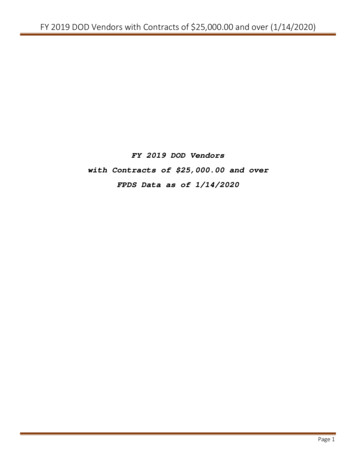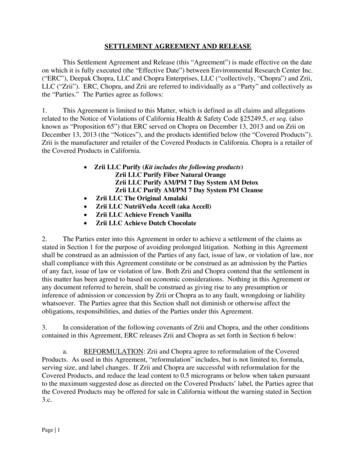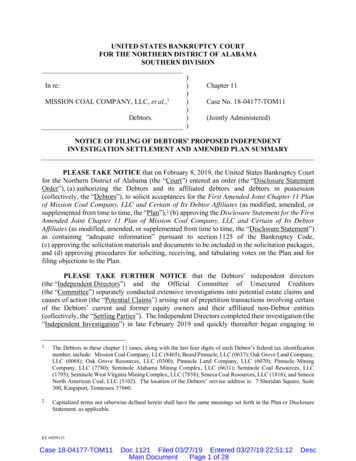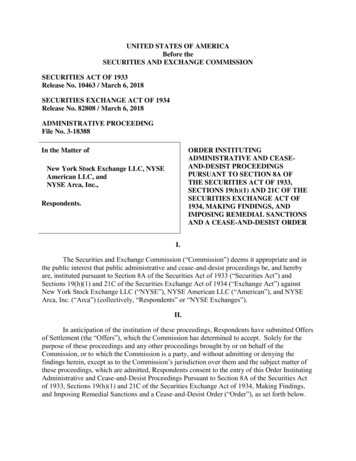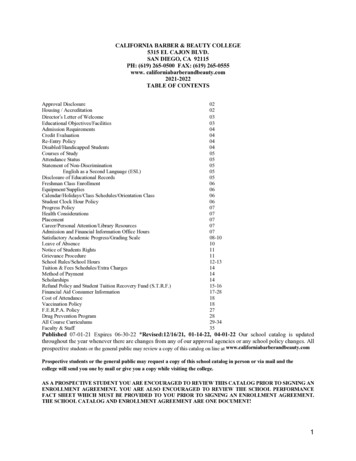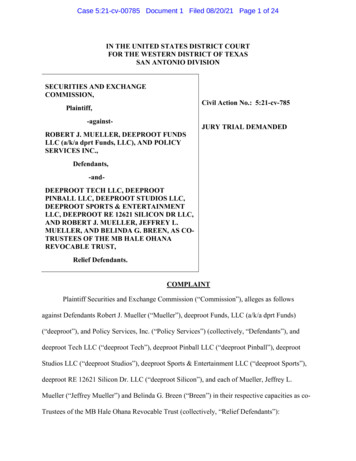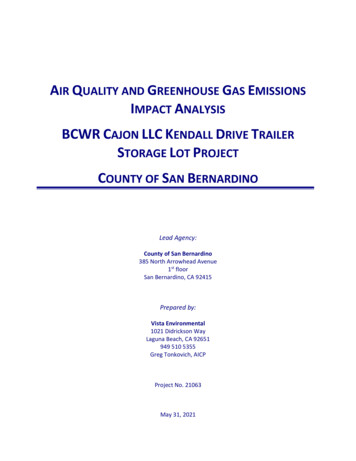
Transcription
AIR QUALITY AND GREENHOUSE GAS EMISSIONSIMPACT ANALYSISBCWR CAJON LLC KENDALL DRIVE TRAILERSTORAGE LOT PROJECTCOUNTY OF SAN BERNARDINOLead Agency:County of San Bernardino385 North Arrowhead Avenue1st floorSan Bernardino, CA 92415Prepared by:Vista Environmental1021 Didrickson WayLaguna Beach, CA 92651949 510 5355Greg Tonkovich, AICPProject No. 21063May 31, 2021
TABLE OF CONTENTS1.0Introduction . 11.1 Purpose of Analysis and Study Objectives . 11.2 Site Location and Study Area . 11.3 Proposed Project Description . 11.4 Executive Summary . 21.5 Mitigation Measures for the Proposed Project . 32.0Air Pollutants . 62.1 Criteria Pollutants and Ozone Precursors . 62.2 Other Pollutants of Concern . 83.0Greenhouse Gases . 103.1 Greenhouse Gases . 103.2 Global Warming Potential . 123.3 Greenhouse Gas Emissions Inventory. 134.0Air Quality Management . 144.1 Federal – United States Environmental Protection Agency. 144.2 State – California Air Resources Board . 174.3 Regional – Southern California . 184.4 Local – County of San Bernardino . 215.0Global Climate Change Management . 225.1 International . 225.2 Federal – United States Environmental Protection Agency. 225.3 State . 235.4 Regional – Southern California . 305.5 Local – County of San Bernardino . 306.0Atmospheric Setting . 326.1 South Coast Air Basin . 326.2 Local Climate . 326.3 Monitored Local Air Quality . 336.2 Toxic Air Contaminant Levels . 357.0Modeling Parameters and Assumptions . 367.1 CalEEMod Model Input Parameters . 368.0Thresholds of Significance. 398.1 Regional Air Quality . 398.2 Local Air Quality . 398.3 Toxic Air Contaminants . 408.4 Odor Impacts. 408.5 Greenhouse Gas Emissions . 40BCWR Cajon LLC Kendall Dr. Trailer Storage Lot Project, Air Quality and GHG Emissions Impact AnalysisCounty of San BernardinoPage i
TABLE OF CONTENTS CONTINUED9.0Impact Analysis . 429.1 CEQA Thresholds of Significance. 429.2 Air Quality Compliance . 429.3 Cumulative Net Increase in Non‐Attainment Pollution . 439.4 Sensitive Receptors . 499.5 Odor Emissions Adversely Affecting a Substantial Number of People . 519.6 Generation of Greenhouse Gas Emissions. 529.7 Greenhouse Gas Plan Consistency . 5310.0References. 55APPENDICESAppendix A – CalEEMod Model Daily PrintoutsAppendix B – CalEEMod Model Annual PrintoutsBCWR Cajon LLC Kendall Dr. Trailer Storage Lot Project, Air Quality and GHG Emissions Impact AnalysisCounty of San BernardinoPage ii
LIST OF FIGURESFigure 1 – Project Local Study Area . 4Figure 2 – Proposed Site Plan . 5LIST OF TABLESTable A – Global Warming Potentials, Atmospheric Lifetimes and Abundances of GHGs . 12Table B – State and Federal Criteria Pollutant Standards . 14Table C – South Coast Air Basin Attainment Status . 15Table D – Monthly Climate Data . 33Table E – Local Area Air Quality Monitoring Summary . 34Table F – CalEEMod Land Use Parameters . 36Table G – SCAQMD Regional Criteria Pollutant Emission Thresholds of Significance . 39Table H – SCAQMD Local Air Quality Thresholds of Significance . 40Table I – Construction‐Related Regional Criteria Pollutant Emissions . 44Table J – Construction‐Related Local Criteria Pollutant Emissions . 45Table K – Operational Regional Criteria Pollutant Emissions . 46Table L – Operations‐Related Local Criteria Pollutant Emissions . 49Table M – Project Related Greenhouse Gas Annual Emissions . 53BCWR Cajon LLC Kendall Dr. Trailer Storage Lot Project, Air Quality and GHG Emissions Impact AnalysisCounty of San BernardinoPage iii
ACRONYMS AND ABBREVIATIONSABAssembly BillAQMPAir Quality Management PlanBACTBest Available Control TechnologyCAAQSCalifornia Ambient Air Quality StandardsCalEEModCalifornia Emissions Estimator ModelCalEPACalifornia Environmental Protection AgencyCAPCOACalifornia Air Pollution Control Officers AssociationCARBCalifornia Air Resources BoardCEQACalifornia Environmental Quality ActCOCarbon monoxideCountyCounty of San BernardinoDPMDiesel particulate matterEPAEnvironmental Protection AgencyºFFahrenheitFTIPFederal Transportation Improvement ProgramHAPHazardous Air PollutantsLSTLocalized Significant ThresholdsMATESMultiple Air Toxics Exposure StudyMPOMetropolitan Planning OrganizationNAAQSNational Ambient Air Quality StandardsNOxNitrogen oxidesNO2Nitrogen dioxideOPROffice of Planning and ResearchPMParticle matterPM10Particles that are less than 10 micrometers in diameterPM2.5Particles that are less than 2.5 micrometers in diameterPPMParts per millionPPBParts per billionPPTParts per trillionRTIPRegional Transportation Improvement PlanRTP/SCSRegional Transportation Plan/Sustainable Communities StrategyBCWR Cajon LLC Kendall Dr. Trailer Storage Lot Project, Air Quality and GHG Emissions Impact AnalysisCounty of San BernardinoPage iv
SBSenate BillSCAQMDSouth Coast Air Quality Management DistrictSCAGSouthern California Association of GovernmentsSIPState Implementation PlanSOxSulfur oxidesSSABSalton Sea Air BasinTACToxic air contaminantsVOCVolatile organic compoundsBCWR Cajon LLC Kendall Dr. Trailer Storage Lot Project, Air Quality and GHG Emissions Impact AnalysisCounty of San BernardinoPage v
1.0INTRODUCTION1.1 Purpose of Analysis and Study ObjectivesThis Air Quality and Greenhouse Gas (GHG) Emissions Impact Analysis has been completed to determinethe air quality and GHG emissions impacts associated with the proposed BCWR Cajon LLC Kendall DriveTrailer Storage Lot project (proposed project). The following is provided in this report: A description of the proposed project; A description of the atmospheric setting; A description of the criteria pollutants and GHGs; A description of the air quality regulatory framework; A description of the GHG emissions regulatory framework; A description of the air quality and GHG emissions thresholds including the CaliforniaEnvironmental Quality Act (CEQA) significance thresholds; An analysis of the conformity of the proposed project with the South Coast Air QualityManagement District (SCAQMD) Air Quality Management Plan (AQMP); An analysis of the short‐term construction related and long‐term operational air quality and GHGemissions impacts; and An analysis of the conformity of the proposed project with all applicable GHG emissions reductionplans and policies.1.2 Site Location and Study AreaThe project site is located in an unincorporated area of San Bernardino County (County). Theapproximately 7.17‐acre project site is currently vacant and is bounded by Kendall Drive and mixed‐use(industrial and residential) uses to the northeast, the BNSF/UP Cajon Line Railroad and vacant land to thesouth, and Cajon Boulevard and industrial uses to the west. The project local study area is shown in Figure1.Sensitive Receptors in Project VicinityThe nearest sensitive receptors to the project site are homes located in the mixed‐use (industrial andresidential) area on the northeast side of Kendall Drive that are as near as 80 feet from the project site.The nearest school to the project site is Cesar Chavez Middle School that is located approximately 0.8 mileto the east of the project site.1.3 Proposed Project DescriptionThe proposed project would consist of development of a 209 stall trailer storage lot that would include a170 square foot guard shack with restroom and 58,344 square feet of landscaped area. The proposed siteplan is shown in Figure 2.BCWR Cajon LLC Kendall Dr Trailer Storage Lot Project, Air Quality and GHG Emissions Impact AnalysisCounty of San BernardinoPage 1
1.4 Executive SummaryStandard Air Quality and GHG Regulatory ConditionsThe proposed project will be required to comply with the following regulatory conditions from theSCAQMD and State of California (State).South Coast Air Quality Management District RulesThe following lists the SCAQMD rules that are applicable, but not limited to the proposed project. Rule 402 Nuisance – Controls the emissions of odors and other air contaminants; Rule 403 Fugitive Dust – Controls the emissions of fugitive dust; Rules 1108 and 1108.1 Cutback and Emulsified Asphalt – Controls the VOC content in asphalt; Rule 1113 Architectural Coatings – Controls the VOC content in paints and solvents; and Rule 1143 Paint Thinners – Controls the VOC content in paint thinners.State of California RulesThe following lists the State of California Code of Regulations (CCR) air quality emission rules that areapplicable, but not limited to the proposed project. CCR Title 13, Article 4.8, Chapter 9, Section 2449 – In use Off‐Road Diesel Vehicles; CCR Title 13, Section 2025 – On‐Road Diesel Truck Fleets; CCR Title 24 Part 6 – California Building Energy Standards; and CCR Title 24 Part 11 – California Green Building Standards.Summary of Analysis ResultsThe following is a summary of the proposed project’s impacts with regard to the State CEQA Guidelinesair quality checklist questions.Conflict with or obstruct implementation of the applicable air quality plan?Less than significant impact.Result in a cumulatively considerable net increase of any criteria pollutant for which the project region isnon‐attainment under an applicable Federal or State ambient air quality standard?Less than significant impact.Expose sensitive receptors to substantial pollutant concentrations?Less than significant impact.Result in other emissions (such as those leading to odors) adversely affecting a substantial number ofpeople?Less than significant impact.BCWR Cajon LLC Kendall Dr Trailer Storage Lot Project, Air Quality and GHG Emissions Impact AnalysisCounty of San BernardinoPage 2
Generate GHG emissions, either directly or indirectly, that may have a significant impact on theenvironment?Less than significant impact.Conflict with any applicable plan, policy or regulation of an agency adopted for the purpose of reducingthe emissions of GHGs?Less than significant impact.1.5 Mitigation Measures for the Proposed ProjectThis analysis found that implementation of the State and SCAQMD air quality and GHG emissionsreductions regulations were adequate to limit criteria pollutants, toxic air contaminants, odors, and GHGemissions from the proposed project to less than significant levels. No mitigation measures are requiredfor the proposed project with respect to air quality and GHG emissions.BCWR Cajon LLC Kendall Dr Trailer Storage Lot Project, Air Quality and GHG Emissions Impact AnalysisCounty of San BernardinoPage 3
NSOURCE: Google Maps.ctojePreSitFigure 1Project Local Study Area
SOURCE: Van Dam Engineering.Figure 2Proposed Site Plan
2.0AIR POLLUTANTSAir pollutants are generally classified as either criteria pollutants or non‐criteria pollutants. Federalambient air quality standards have been established for criteria pollutants, whereas no ambient standardshave been established for non‐criteria pollutants. For some criteria pollutants, separate standards havebeen set for different periods. Most standards have been set to protect public health. For somepollutants, standards have been based on other values (such as protection of crops, protection ofmaterials, or avoidance of nuisance conditions). A summary of federal and state ambient air qualitystandards is provided in the Regulatory Framework section.2.1 Criteria Pollutants and Ozone PrecursorsThe criteria pollutants consist of: ozone, nitrogen oxides (NOx), CO, sulfur oxides (SOx), lead, andparticulate matter (PM). The ozone precursors consist of NOx and VOC. These pollutants can harm yourhealth and the environment, and cause property damage. The Environmental Protection Agency (EPA)calls these pollutants “criteria” air pollutants because it regulates them by developing human health‐based and/or environmentally‐based criteria for setting permissible levels. The following providesdescriptions of each of the criteria pollutants and ozone precursors.Nitrogen OxidesNOx is the generic term for a group of highly reactive gases which contain nitrogen and oxygen. Whilemost NOx are colorless and odorless, concentrations of nitrogen dioxide (NO2) can often be seen as areddish‐brown layer over many urban areas. NOx form when fuel is burned at high temperatures, as in acombustion process. The primary manmade sources of NOx are motor vehicles, electric utilities, and otherindustrial, commercial, and residential sources that burn fuel. NOx reacts with other pollutants to form,ground‐level ozone, nitrate particles, acid aerosols, as well as NO2, which cause respiratory problems. NOxand the pollutants formed from NOx can be transported over long distances, following the patterns ofprevailing winds. Therefore, controlling NOx is often most effective if done from a regional perspective,rather than focusing on the nearest sources.OzoneOzone is not usually emitted directly into the air but in the vicinity of ground‐level is created by a chemicalreaction between NOx and VOC in the presence of sunlight. Motor vehicle exhaust, industrial emissions,gasoline vapors, chemical solvents as well as natural sources emit NOx and VOC that help form ozone.Ground‐level ozone is the primary constituent of smog. Sunlight and hot weather cause ground‐levelozone to form with the greatest concentrations usually occurring downwind from urban areas. Ozone issubsequently considered a regional pollutant. Ground‐level ozone is a respiratory irritant and an oxidantthat increases susceptibility to respiratory infections and can cause substantial damage to vegetation andother materials. Because NOx and VOC are ozone precursors, the health effects associated with ozoneare also indirect health effects associated with significant levels of NOx and VOC emissions.Carbon MonoxideCarbon monoxide (CO) is a colorless, odorless gas that is formed when carbon in fuel is not burnedcompletely. It is a component of motor vehicle exhaust, which contributes approximately 56 percent ofall CO emissions nationwide. In cities, 85 to 95 percent of all CO emissions may come from motor vehicleexhaust. Other sources of CO emissions include industrial processes (such as metals processing andchemical manufacturing), residential wood burning, and natural sources such as forest fires. Woodstoves,BCWR Cajon LLC Kendall Dr Trailer Storage Lot Project, Air Quality and GHG Emissions Impact AnalysisCounty of San BernardinoPage 6
gas stoves, cigarette smoke, and unvented gas and kerosene space heaters are indoor sources of CO. Thehighest levels of CO in the outside air typically occur during the colder months of the year when inversionconditions are more frequent. The air pollution becomes trapped near the ground beneath a layer ofwarm air. CO is described as having only a local influence because it dissipates quickly. Since COconcentrations are strongly associated with motor vehicle emissions, high CO concentrations generallyoccur in the immediate vicinity of roadways with high traffic volumes and traffic congestion, active parkinglots, and in automobile tunnels. Areas adjacent to heavily traveled and congested intersections areparticularly susceptible to high CO concentrations.CO is a public health concern because it combines readily with hemoglobin and thus reduces the amountof oxygen transported in the bloodstream. The health threat from lower levels of CO is most serious forthose who suffer from heart disease such as angina, clogged arteries, or congestive heart failure. For aperson with heart disease, a single exposure to CO at low levels may cause chest pain and reduce thatperson’s ability to exercise; repeated exposures may contribute to other cardiovascular effects. Highlevels of CO can affect even healthy people. People who breathe high levels of CO can develop visionproblems, reduced ability to work or learn, reduced manual dexterity, and difficulty performing complextasks. At extremely high levels, CO is poisonous and can cause death.Sulfur OxidesSOx gases are formed when fuel containing sulfur, such as coal and oil is burned, as well as from therefining of gasoline. SOx dissolves easily in water vapor to form acid and interacts with other gases andparticles in the air to form sulfates and other products that can be harmful to people and the environment.LeadLead is a metal found naturally in the environment as well as manufactured products. The major sourcesof lead emissions have historically been motor vehicles and industrial sources. Due to the phase out ofleaded gasoline, metal processing is now the primary source of lead emissions to the air. High levels oflead in the air are typically only found near lead smelters, waste incinerators, utilities, and lead‐acidbattery manufacturers. Exposure of fetuses, infants and children to low levels of lead can adversely affectthe development and function of the central nervous system, leading to learning disorders, distractibility,inability to follow simple commands, and lower intelligence quotient. In adults, increased lead levels areassociated with increased blood pressure.Particulate MatterPM is the term for a mixture of solid particles and liquid droplets found in the air. PM is made up of anumber of components including acids (such as nitrates and sulfates), organic chemicals, metals, and soilor dust particles. The size of particles is directly linked to their potential for causing health problems.Particles that are less than 10 micrometers in diameter (PM10) that are also known as RespirableParticulate Matter are the particles that generally pass through the throat and nose and enter the lungs.Once inhaled, these particles can affect the heart and lungs and cause serious health effects. Particlesthat are less than 2.5 micrometers in diameter (PM2.5) that are also known as Fine Particulate Matterhave been designated as a subset of PM10 due to their increased negative health impacts and its abilityto remain suspended in the air longer and travel further.Volatile Organic CompoundsHydrocarbons are organic gases that are formed from hydrogen and carbon and sometimes otherelements. Hydrocarbons that contribute to formation of ozone are referred to and regulated as VOCs (alsoBCWR Cajon LLC Kendall Dr Trailer Storage Lot Project, Air Quality and GHG Emissions Impact AnalysisCounty of San BernardinoPage 7
referred to as reactive organic gases). Combustion engine exhaust, oil refineries, and fossil‐fueled powerplants are the sources of hydrocarbons. Other sources of hydrocarbons include evaporation frompetroleum fuels, solvents, dry cleaning solutions, and paint.VOC is not classified as a criteria pollutant, since VOCs by themselves are not a known source of adversehealth effects. The primary health effects of VOCs result from the formation of ozone and its related healtheffects. High levels of VOCs in the atmosphere can interfere with oxygen intake by reducing the amountof available oxygen through displacement. Carcinogenic forms of hydrocarbons, such as benzene, areconsidered TACs. There are no separate health standards for VOCs as a group.2.2 Other Pollutants of ConcernToxic Air ContaminantsIn addition to the above‐listed criteria pollutants, TACs are another group of pollutants of concern. TACsis a term that is defined under the California Clean Air Act and consists of the same substances that aredefined as Hazardous Air Pollutants (HAPs) in the Federal Clean Air Act. There are over 700 hundreddifferent types of TACs with varying degrees of toxicity. Sources of TACs include industrial processes suchas petroleum refining and chrome plating operations, commercial operations such as gasoline stationsand dry cleaners, and motor vehicle exhaust. Cars and trucks release at least 40 different toxic aircontaminants. The most important of these TACs, in terms of health risk, are diesel particulates, benzene,formaldehyde, 1,3‐butadiene, and acetaldehyde. Public exposure to TACs can result from emissions fromnormal operations as well as from accidental releases. Health effects of TACs include cancer, birth defects,neurological damage, and death.TACs are less pervasive in the urban atmosphere than criteria air pollutants, however they are linked toshort‐term (acute) or long‐term (chronic or carcinogenic) adverse human health effects. There arehundreds of different types of TACs with varying degrees of toxicity. Sources of TACs include industrialprocesses, commercial operations (e.g., gasoline stations and dry cleaners), and motor vehicle exhaust.According to The California Almanac of Emissions and Air Quality 2013 Edition, the majority of theestimated health risk from TACs can be attributed to relatively few compounds, the most important ofwhich is DPM. DPM is a subset of PM2.5 because the size of diesel particles are typically 2.5 microns andsmaller. The identification of DPM as a TAC in 1998 led the California Air Resources Board (CARB) to adoptthe Risk Reduction Plan to Reduce Particulate Matter Emissions from Diesel‐fueled Engines and Vehiclesin September 2000. The plan’s goals are a 75‐percent reduction in DPM by 2010 and an 85‐percentreduction by 2020 from the 2000 baseline. Diesel engines emit a complex mixture of air pollutants,composed of gaseous and solid material. The visible emissions in diesel exhaust are known as particulatematter or PM, which includes carbon particles or “soot.” Diesel exhaust also contains a variety of harmfulgases and over 40 other cancer‐causing substances. California’s identification of DPM as a toxic aircontaminant was based on its potential to cause cancer, premature deaths, and other health problems.Exposure to DPM is a health hazard, particularly to children whose lungs are still developing and theelderly who may have other serious health problems. Overall, diesel engine emissions are responsible forthe majority of California’s potential airborne cancer risk from combustion sources.AsbestosAsbestos is listed as a TAC by CARB and as a HAP by the EPA. Asbestos occurs naturally in mineralformations and crushing or breaking these rocks, through construction or other means, can releaseBCWR Cajon LLC Kendall Dr Trailer Storage Lot Project, Air Quality and GHG Emissions Impact AnalysisCounty of San BernardinoPage 8
asbestiform fibers into the air. Asbestos emissions can result from the sale or use of asbestos‐containingmaterials, road surfacing with such materials, grading activities, and surface mining. The risk of disease isdependent upon the intensity and duration of exposure. When inhaled, asbestos fibers may remain inthe lungs and with time may be linked to such diseases as asbestosis, lung cancer, and mesothelioma. Thenearest likely locations of naturally occurring asbestos, as identified in the General Location Guide forUltramafic Rocks in California, prepared by the California Division of Mines and Geology, is located inSanta Barbara County. The nearest historic asbestos mine to the project site, as identified in the ReportedHistoric Asbestos Mines, Historic Asbestos Prospects, and Other Natural Occurrences of Asbestos inCalifornia, prepared by U.S. Geological Survey, is located at Asbestos Mountain, which is approximately60 miles southeast of the project site in the San Jacinto Mountains. Due to the distance to the nearestnatural occurrences of asbestos, the project site is not likely to contain asbestos.BCWR Cajon LLC Kendall Dr Trailer Storage Lot Project, Air Quality and GHG Emissions Impact AnalysisCounty of San BernardinoPage 9
3.0GREENHOUSE GASES3.1 Greenhouse GasesConstituent gases of the Earth’s atmosphere, called atmospheric GHGs, play a critical role in the Earth’sradiation amount by trapping infrared radiation from the Earth’s surface, which otherwise would haveescaped to space. Prominent greenhouse gases contributing to this process include carbon dioxide (CO2),methane (CH4), ozone, water vapor, nitrous oxide (N2O), and chlorofluorocarbons (CFCs). Thisphenomenon, known as the Greenhouse Effect, is responsible for maintaining a habitable climate.Anthropogenic (caused or produced by humans) emissions of these greenhouse gases in excess of naturalambient concentrations are responsible for the enhancement of the Greenhouse Effect and have led to atrend of unnatural warming of the Earth’s natural climate, known as global warming or climate change.Emissions of gases that induce global warming are attributable to human activities associated withindustrial/manufacturing, agriculture, utilities, transportation, and residential land uses. Emissions of CO2and N2O are byproducts of fossil fuel combust
The criteria pollutants consist of: ozone, nitrogen oxides (NOx), CO, sulfur oxides (SOx), lead, and particulate matter (PM). The ozone precursors consist of NOx and VOC. These pollutants can harm your health and the environment, and cause property damage. The Environmental Protection Agency (EPA)

